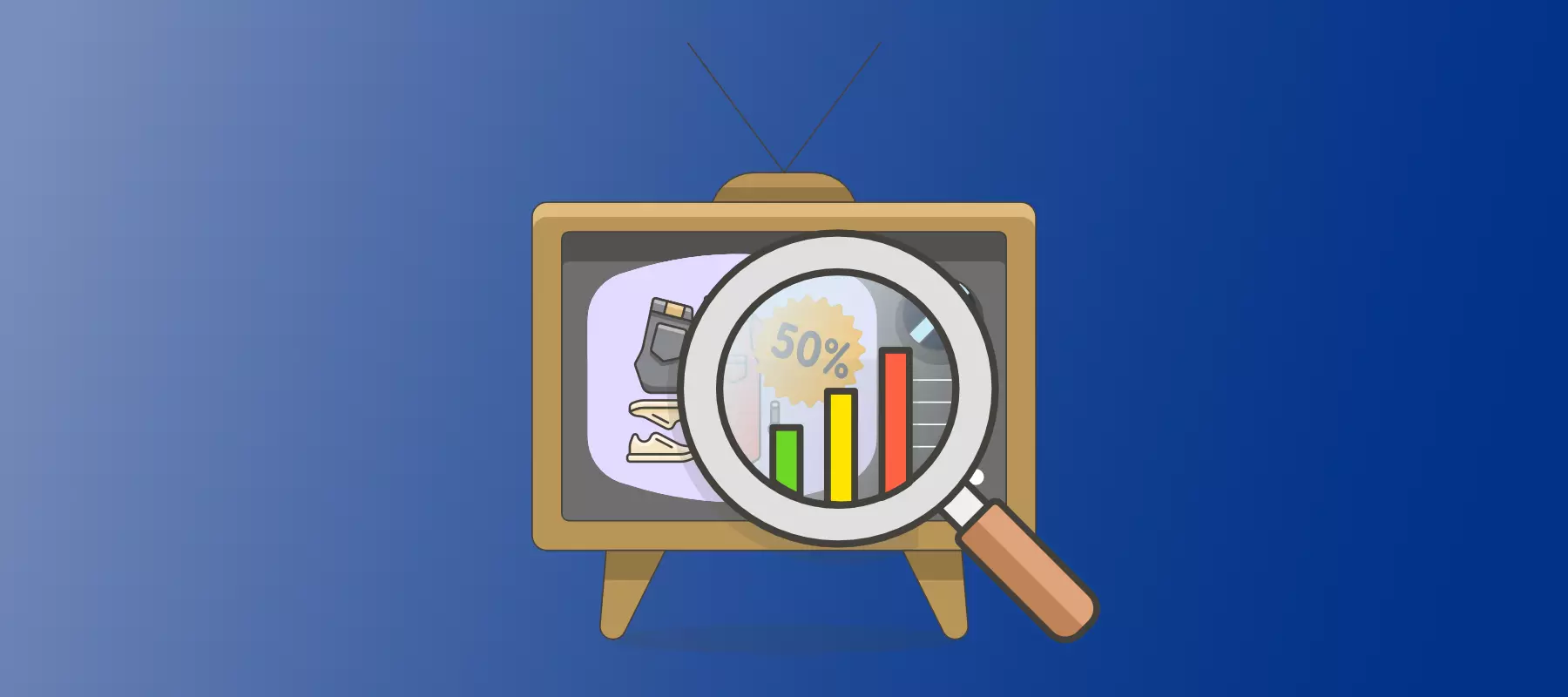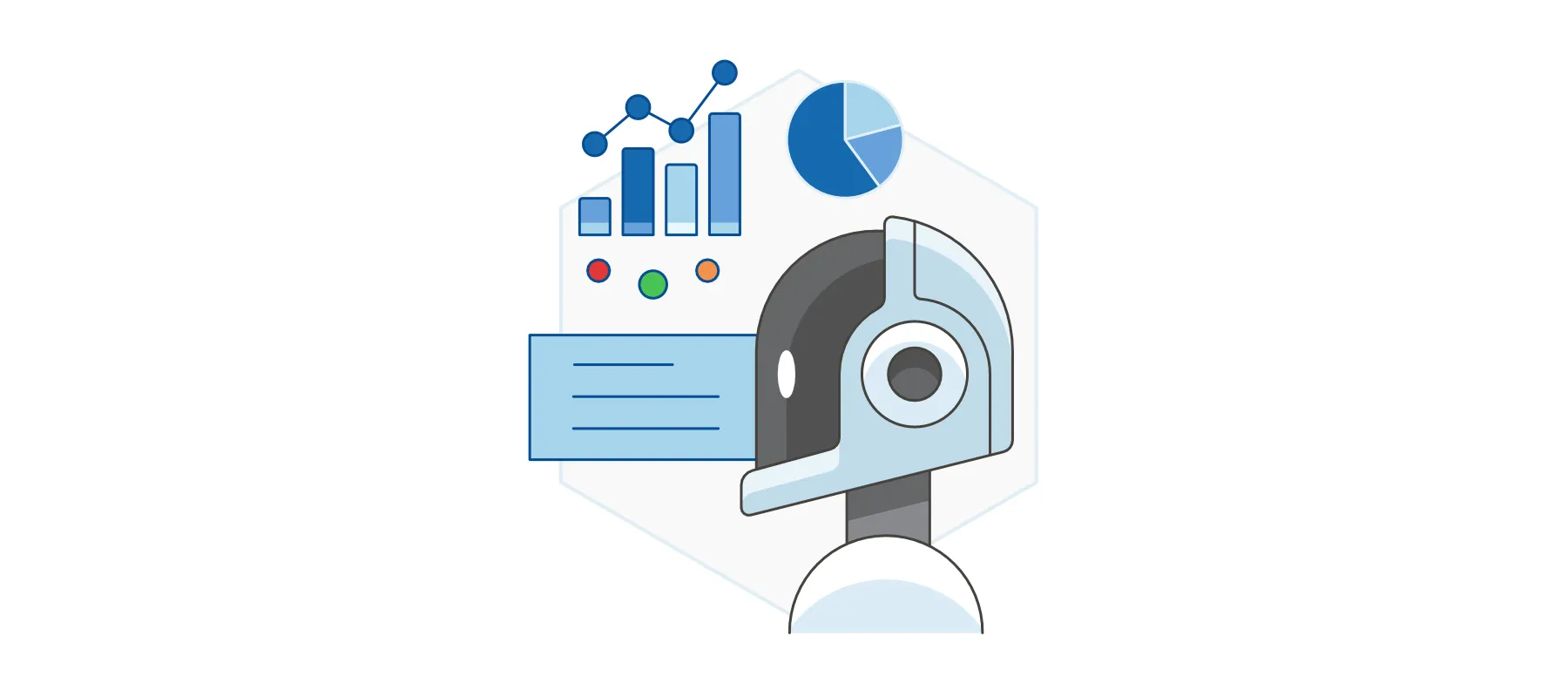Conversion Rate Explained
Published: Jun 25th 2020 | 7 min read
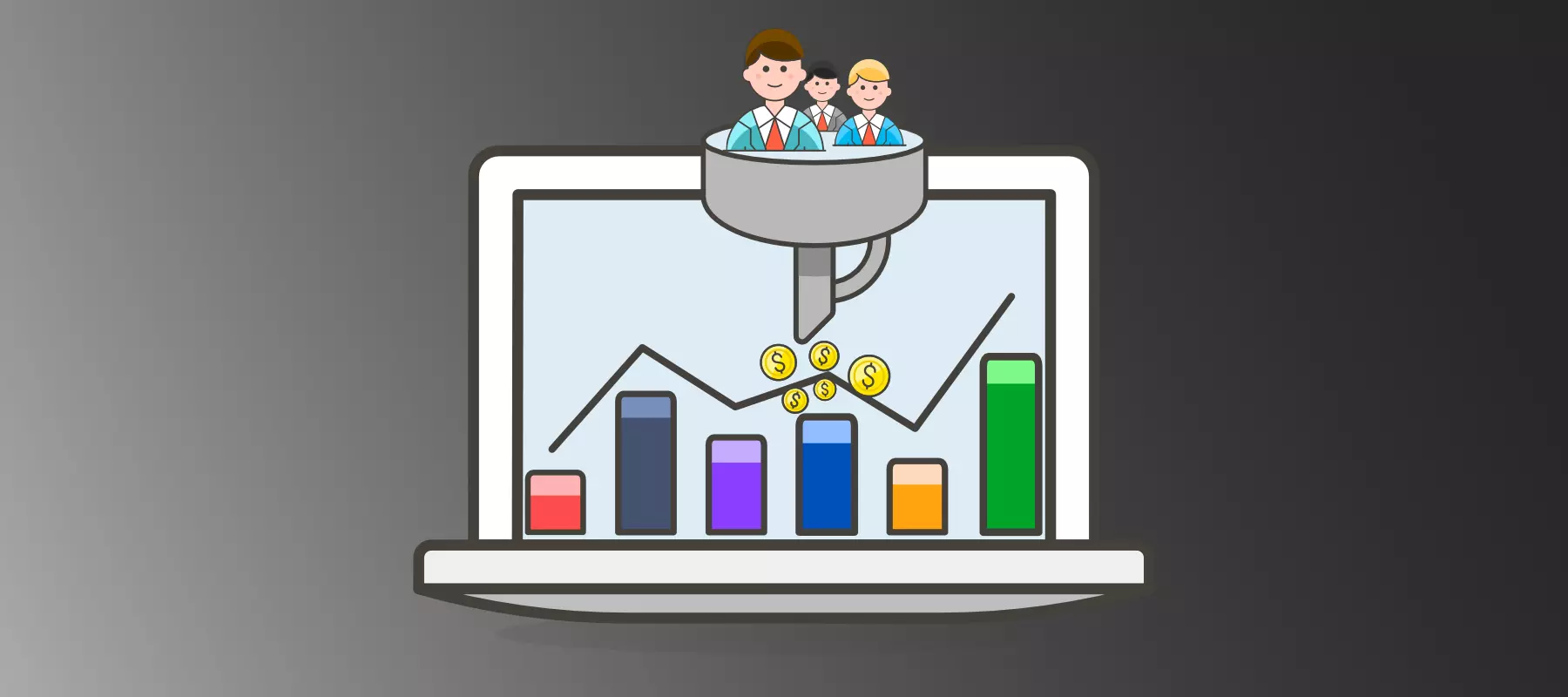
In reality, you probably wouldn't want your site to be on one of those lists. However, there is a way to make the conversion rate really matter as a metric that can help you improve your site.
There are three things to review:
- What is the conversion rate?
- Why isn't it the answer to all of the world's problems?
- What can you do to make a conversion rate more meaningful?
What is Conversion Rate?
The conversion rate is the percentage of visits to your site that result in a conversion. For most site owners, a conversion can be a sale or a lead of some kind, typically related to the number of visits or sessions:
If your store is visited 100 times and 5 of those visits end in a sale, you have a 5% conversion rate.
The reason people care about that, and the big idea behind conversion optimization, is that if you can figure out how to increase your conversion percentage, you will increase sales for the same traffic costs.
But that isn’t exactly the case.
Why Conversion Rate Isn't the Answer to All Your Problems
A higher conversion rate doesn't always mean higher performance.
The simplest way to explain this is with an example. Here are the stats for two days of activity on one e-commerce site:
- Day 1: 4% conversion rate. (5000 visits, 200 sales)
- Day 2: 10% conversion rate. (1000 visits, 100 sales)
On the second day, the conversion was more than double the rate from day 1. Yet, it's easy to see day one was a much better day for the business (assuming all outgoing costs were the same).
When focusing on a conversion number, we are pretending that every visit to our site is a potential sale. Although, not all visits to your site have the potential to convert. While that might be true for a particular PPC landing page, it is very rarely true for an entire site.
Visitors may be checking the status of their orders, looking for your phone number, job hunting, grabbing a link to share with a friend, or any number of other activities. Focusing purely on improving the overall conversion rate from any given visit ignores scores of other possibilities.
It’s also possible that making your site more engaging may reduce your conversion rate.
Let's say you have an e-shop, with absolutely no content other than products. Your average customer comes to the site once a month and buys once every two months. To try and improve this, you add a blog to the site with really engaging content. Suddenly, your average customer is visiting the site twice a week.
To maintain your conversion rate, you'd have to persuade your longtime loyal customers to buy once per week, instead of once every two months. In other words, your site has most definitely improved, and it's very likely your headline conversion rate will go down. Conversion rates vary wildly based on the visitor type.
Conversion rates vary wildly based on the visitor type
A first-time visitor to your site who has never bought your products, is far, far less likely to make a purchase than an existing, proven-to-be-loyal customer. On the opposite, a very loyal customer and a regular visitor are far less likely to be influenced to make a purchase because of minor conversion tweaks.
Combining those two groups together is like putting first-time house buyers into a big pot with castle owners and trying to make sense of the strange average housing prices.
Visitors from different traffic sources also differ wildly. Direct visitors convert well as that user group tends to contain more existing customers. Likewise, brand and non-brand search terms, generic and long-tail terms vary too.
That’s where users come in.

The thing is, growing your site will often decrease conversion rates.
Look at another example:
Here are 2 alternative tables of numbers for a site bringing in £565k in revenue over the period we're looking at.
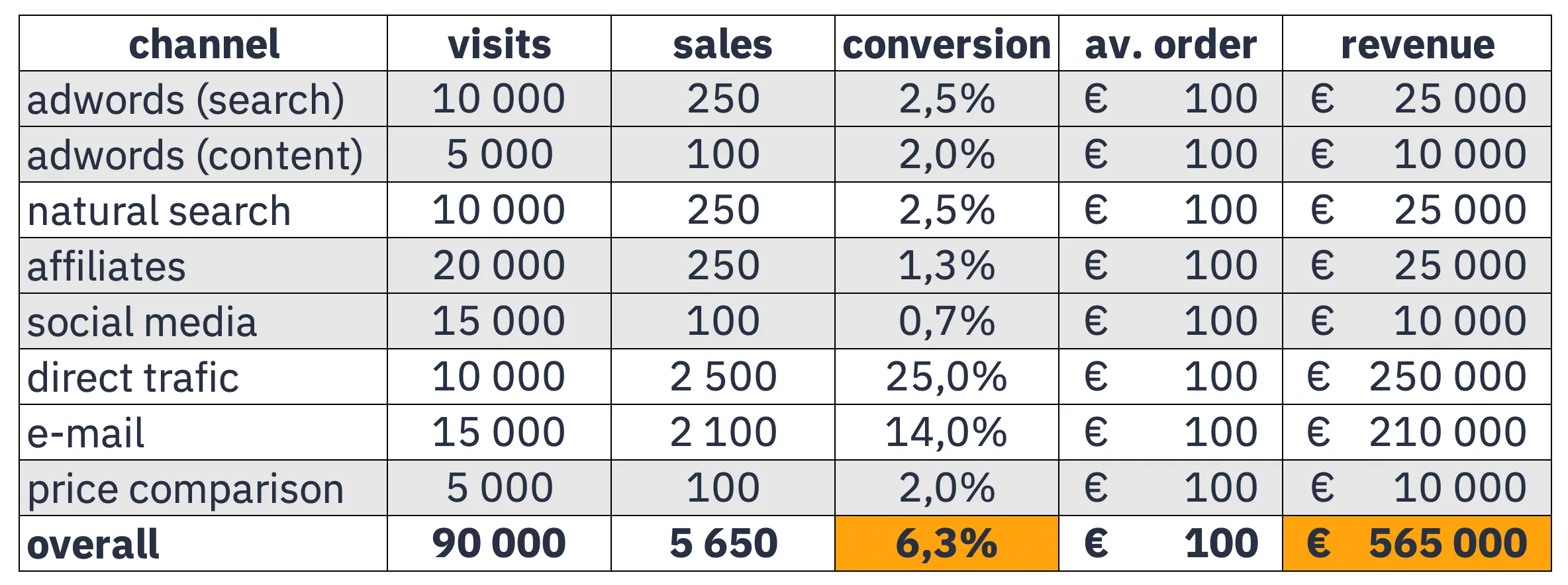
We can see most channels convert between 1% and 3%, yet visits "direct" to the site & via "email" are far more likely to result in a customer purchase (25% chance and 14% chance).
Hence, the focus sits considerately on the best converting channels. We send out more emails, and we turn off many of the other channels:
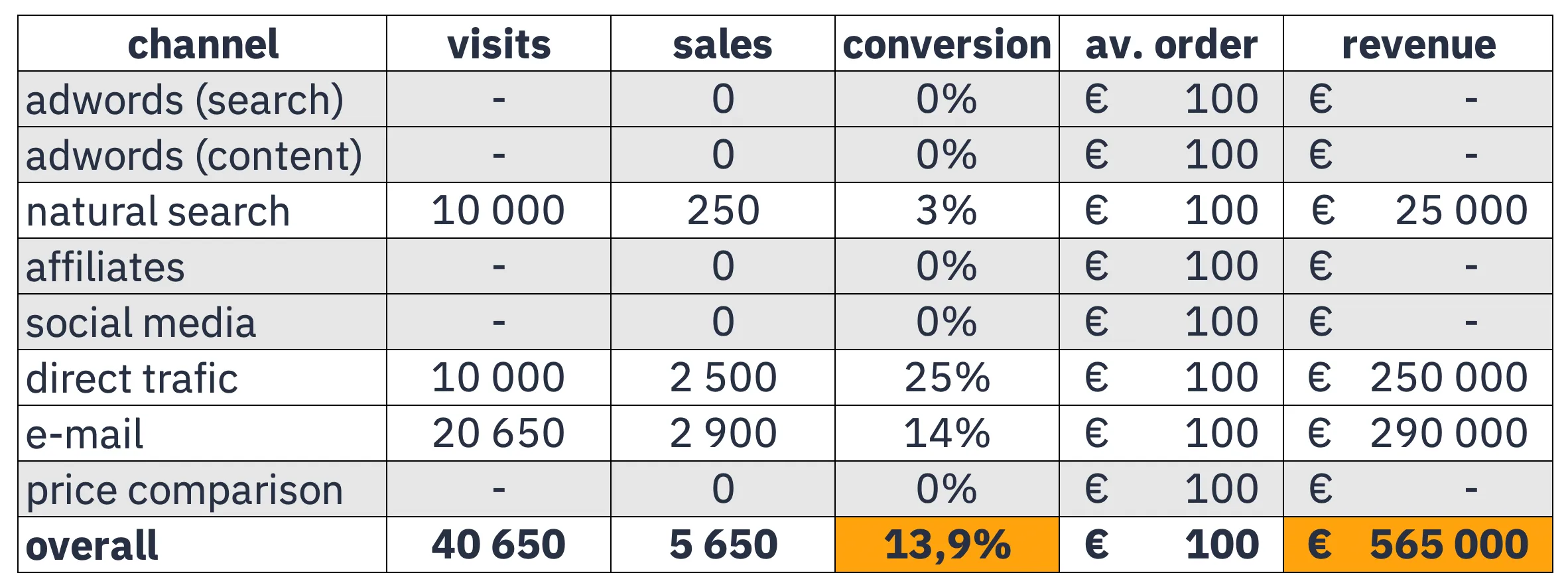
The overall conversion rate has more than doubled. Revenue is the same, and we've probably saved a lot of advertising costs.
That all looks fantastic at first glance. However, we've turned off most of the growth channels of the site. Look at the second table again and ask:
- In a year's time, will we still be able to squeeze out new sales from our same old email list?
- Will we be able to win back the customers our competitors have grabbed from us through their PPC and affiliate campaigns?
Make Conversion Rates Meaningful Again
Despite all of these ugly limitations (and more), the conversion is still an incredibly powerful tool. Here are some tips to make more sense of conversion and take impactful steps to improve your results.
Measure conversion rates contextually, not literally
An increase in conversion rate can be caused by a vast decrease in visitors coupled with a gentler decrease in sales.
Use it as a question prompt rather than an answer
"My conversion rate has gone up 3%, why?" Avoid using "my conversion rate has gone up 3%" as a declaration of results.
It works (really well) for very specific tasks
- Building individual landing pages around conversion
- Putting together an email with conversion in mind.
Break your conversion rate down by channel
- Generally, acquisition channels like non-brand pay-per-click will convert at a far lower rate than your site average. Seeking to improve those rates individually will save you (and make you) far more money than treating it as part of a bigger 'overall conversion' number.
- Separate out your channels, figure out which you can impact through conversion optimization, and focus on those instead of your headline conversion rate.
Break conversion rate down by visitor type
- Split out "new visitors" and "returning visitors" (or better yet, "previous buyers" and "never bought before").
- Remember that superficial site changes are far more likely to affect new visitors than old visitors. Your existing customers are swayed by brand, service, product quality, delivery, etc. Your new visitors are far more swayed by perception.
Break it down by task
- If your site has several key tasks (e.g. sales, customer support inquiries, leads, account top-ups) treat those as separate conversion tasks.
- If they are important to you, split those tasks from each other, and track work to increase their rates individually.
Focus on micro conversions
- Instead of asking "how can I increase the conversion rate of my site?" and wondering where to look first, break this down into smaller chunks.
- Start with your most important pages & journeys, e.g. "what percentage of searches result in a click to a product page? What can I change about our search results to improve that?"
Increasing conversion rates has been one of our main goals and we have successfully helped our clients to improve the performance of their websites.
Get in touch with us and discover how we can help you increase conversions, retention rates, and performance of your marketing strategy.
Read more about our solutions:
Increase your TV Ad effectiveness

